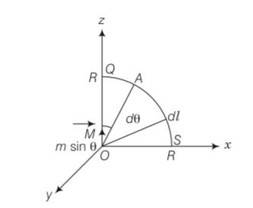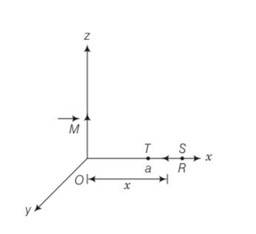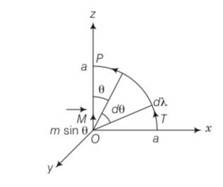Verify the Ampere’s law for magnetic field of a point dipole of dipole moment m = mk . Take C as the closed curve running clockwise along .
(i) The z-axis from z = a > 0 to z = R;
(ii) Along the quarter circle of radius R and centre at the origin, in the first quadrant of x-z plane;
(iii) Along the x-axis from x = R to x = a, and (iv) along the quarter circle of radius a and centre at the origin in the first quadrant of x-z plane.
Verify the Ampere’s law for magnetic field of a point dipole of dipole moment m = mk . Take C as the closed curve running clockwise along .
(i) The z-axis from z = a > 0 to z = R;
(ii) Along the quarter circle of radius R and centre at the origin, in the first quadrant of x-z plane;
(iii) Along the x-axis from x = R to x = a, and (iv) along the quarter circle of radius a and centre at the origin in the first quadrant of x-z plane.
-
1 Answer
-
This is a Long Answer Type Questions as classified in NCERT Exemplar
Explanation- the magnetic field induction at a pojnt z distance from dipole moment is
B=
Along z axis from p to q
=
=
=
(b) the point A lies on the equatorial line of the magnetic dipole of moment Msin
B= dl= Rd

Circular arc = =
(c) along x axis over the path ST

From figure every point lies on the equatorial line of magnetic dipole so
B= the value of B is zero as the angle between M and dl is 90
(d)along the quarter circle TP of radius a

B along circular arc d
B =
Net magnetic field through PQST is zero
Similar Questions for you
There are various important topics in the physics chapter 5 class 12 magnetism and matter. These topics are important for both cases, conceptual and numerical questions. Read below:
- Magnetism
- Bar Magnet as an Electromagnet
- Magnetic Field Due to Magnetic Dipoles
- Type of Magnetic Materials: Ferromagnetic, Paramagnetic, and Diamagnetic
- Magnetisation and Magnetic intensity
- Magnetic Susceptibility
- Magnetic Flux Intensity
- Potential energy due to a magnetic dipole
In JEE Main exam, it is a significant chapter. There can be 6 to 8 questions from this chapter, a weightage of nearly 6.6%.
The exact weightage varies from year to year. This chapter comes under a broader category which can be "Magnetism" or "Modern Physics". In NEET exam, the chapter's weightage is low to moderate and there can be 6-7% of questions from this chapter.
The chapter is one of the small and easy chapter of class 12 Physics. It includes - properties of magnetic materials, magnetic dipoles, and Earth's magnetic field.
When the electric charges moves, it creates attraction or repulsion. It creates magnetic forces and fields and called magnetism. The term "magnetism and matter" talks about the way magnetic forces and matter interact.
Taking an Exam? Selecting a College?
Get authentic answers from experts, students and alumni that you won't find anywhere else
Sign Up on ShikshaOn Shiksha, get access to
- 65k Colleges
- 1.2k Exams
- 679k Reviews
- 1800k Answers
